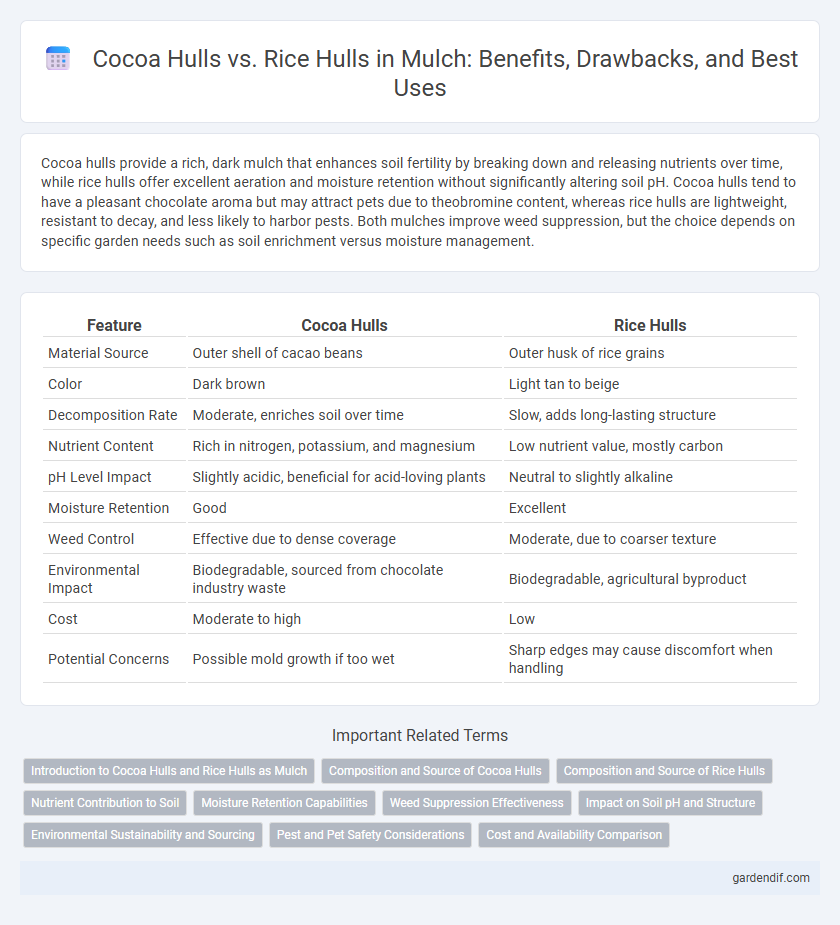
Cocoa Hulls vs Rice Hulls Illustration
Cocoa hulls provide a rich, dark mulch that enhances soil fertility by breaking down and releasing nutrients over time, while rice hulls offer excellent aeration and moisture retention without significantly altering soil pH. Cocoa hulls tend to have a pleasant chocolate aroma but may attract pets due to theobromine content, whereas rice hulls are lightweight, resistant to decay, and less likely to harbor pests. Both mulches improve weed suppression, but the choice depends on specific garden needs such as soil enrichment versus moisture management.
Table of Comparison
| Feature | Cocoa Hulls | Rice Hulls |
|---|---|---|
| Material Source | Outer shell of cacao beans | Outer husk of rice grains |
| Color | Dark brown | Light tan to beige |
| Decomposition Rate | Moderate, enriches soil over time | Slow, adds long-lasting structure |
| Nutrient Content | Rich in nitrogen, potassium, and magnesium | Low nutrient value, mostly carbon |
| pH Level Impact | Slightly acidic, beneficial for acid-loving plants | Neutral to slightly alkaline |
| Moisture Retention | Good | Excellent |
| Weed Control | Effective due to dense coverage | Moderate, due to coarser texture |
| Environmental Impact | Biodegradable, sourced from chocolate industry waste | Biodegradable, agricultural byproduct |
| Cost | Moderate to high | Low |
| Potential Concerns | Possible mold growth if too wet | Sharp edges may cause discomfort when handling |
Introduction to Cocoa Hulls and Rice Hulls as Mulch
Cocoa hulls and rice hulls are natural mulch materials derived from agricultural byproducts, offering eco-friendly ground cover options for gardens. Cocoa hulls provide a rich, dark color and a pleasant chocolate aroma while improving soil aeration and moisture retention, though they may attract pets if ingested. Rice hulls are lightweight, highly renewable mulch that decomposes slowly, enhancing soil texture without altering pH, making them ideal for suppressing weeds and conserving soil moisture.
Composition and Source of Cocoa Hulls
Cocoa hulls, byproducts of the chocolate industry, consist primarily of fibrous materials rich in lignin and cellulose, providing excellent moisture retention and soil aeration properties. Derived from the outer shell of cacao beans after roasting, they contain natural nutrients like potassium and nitrogen, enhancing soil fertility. In contrast, rice hulls, consisting mainly of silica and lignin from the protective outer covering of rice grains, offer superior weed suppression but lack the nutrient content found in cocoa hulls.
Composition and Source of Rice Hulls
Cocoa hull mulch consists primarily of the outer shell of cacao beans, rich in organic matter and nutrients like nitrogen, phosphorus, and potassium, making it ideal for soil enrichment. Rice hulls, derived from the protective outer covering of rice grains, are composed mainly of silica, lignin, and cellulose, providing excellent aeration and moisture retention without significant nutrient content. Unlike cocoa hulls, rice hulls are a byproduct of rice milling, widely available in rice-producing regions, and valued for their durability and slow decomposition in mulching applications.
Nutrient Contribution to Soil
Cocoa hull mulch enriches soil by releasing nitrogen, phosphorus, and potassium, supporting plant growth and improving soil fertility. Rice hulls contribute primarily in enhancing soil aeration and drainage but provide minimal nutrient content compared to cocoa hulls. For gardeners seeking organic matter with significant nutrient input, cocoa hulls offer a superior option over rice hull mulch.
Moisture Retention Capabilities
Cocoa hull mulch boasts superior moisture retention capabilities compared to rice hulls, helping maintain consistent soil hydration and reducing irrigation frequency. The dense, fibrous composition of cocoa hulls allows better water absorption and slower evaporation rates. In contrast, rice hulls tend to dry out more quickly, making them less effective for long-term moisture conservation in garden beds.
Weed Suppression Effectiveness
Cocoa hull mulch offers superior weed suppression due to its dense texture and ability to create a thick barrier that limits sunlight penetration, effectively inhibiting weed seed germination. Rice hull mulch, while lighter and more porous, allows more light and air to reach the soil, which can result in less effective weed control. Gardeners seeking long-lasting weed suppression often prefer cocoa hulls, particularly in high-weed-pressure environments.
Impact on Soil pH and Structure
Cocoa hulls tend to slightly acidify soil due to their natural acidity, promoting a lower pH suitable for acid-loving plants, while rice hulls are more neutral and less likely to alter soil pH significantly. Both mulches improve soil structure by enhancing aeration and moisture retention; cocoa hulls break down faster, enriching organic content, whereas rice hulls provide longer-lasting physical barriers. Selecting between cocoa and rice hulls depends on desired soil pH adjustment and mulch longevity preferences for optimal plant growth.
Environmental Sustainability and Sourcing
Cocoa hull mulch, derived from the outer shells of cocoa beans, offers a renewable and biodegradable option that enriches soil while reducing agricultural waste. Rice hulls, sourced from the protective coverings of rice grains, provide a sustainable mulch choice due to their abundance as an agricultural byproduct and their ability to improve soil aeration and moisture retention. Both materials support environmental sustainability by repurposing crop residues, yet rice hulls often have a lower carbon footprint due to wider availability and less transportation required in many regions.
Pest and Pet Safety Considerations
Cocoa hull mulch contains theobromine, a toxic compound to dogs and some pets, posing significant safety concerns if ingested. Rice hull mulch is generally non-toxic and safer around pets and children, reducing the risk of poisoning. Both mulches deter pests effectively, but rice hulls are preferred in households with pets due to their lower toxicity.
Cost and Availability Comparison
Cocoa hulls typically cost more than rice hulls due to their limited availability and higher processing requirements. Rice hulls are widely available as a byproduct of rice production, making them a more economical and accessible mulch option. Both materials provide effective weed suppression and moisture retention, but rice hulls offer a budget-friendly solution for large-scale landscaping projects.
Cocoa Hulls vs Rice Hulls Infographic

 gardendif.com
gardendif.com